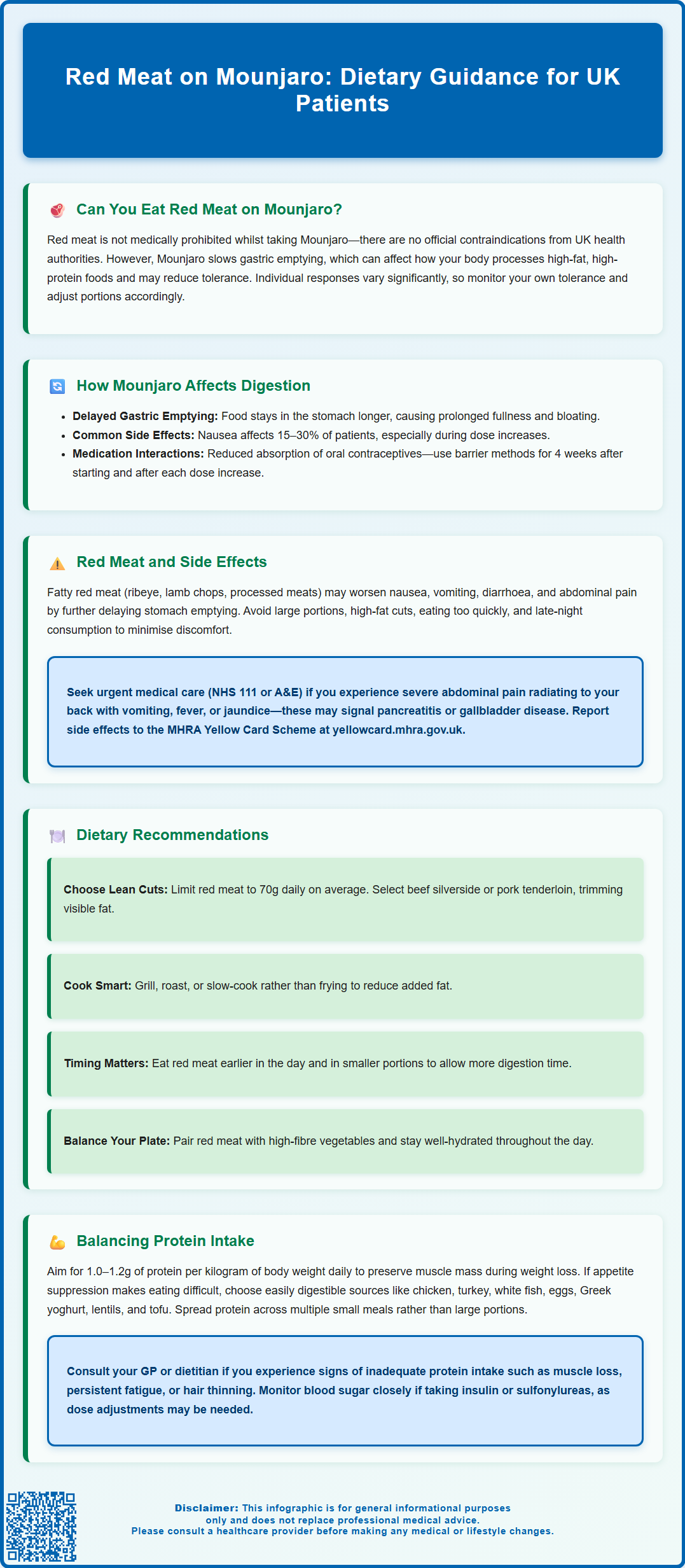Mounjaro®
Dual-agonist support that helps curb appetite, hunger, and cravings to drive substantial, sustained weight loss.
- ~22.5% average body weight loss
- Significant weight reduction
- Improves blood sugar levels
- Clinically proven weight loss

Red meat on Mounjaro (tirzepatide) is not medically restricted, but many patients find their tolerance changes during treatment. Mounjaro is a dual GIP and GLP-1 receptor agonist licensed in the UK for type 2 diabetes and weight management. The medication slows gastric emptying, which can affect how your body processes protein- and fat-rich foods like red meat. Whilst there is no official contraindication from the MHRA or NICE prohibiting red meat consumption, individual responses vary considerably. Some patients naturally reduce their intake due to altered appetite and digestive comfort, whilst others continue eating red meat with adjusted portion sizes and preparation methods.
Summary: Red meat is not contraindicated on Mounjaro (tirzepatide), but many patients experience reduced tolerance due to delayed gastric emptying and may need to adjust portion sizes and choose leaner cuts.
Yes, you can eat red meat while taking Mounjaro (tirzepatide), but many patients find they need to adjust their portion sizes and frequency. There is no official contraindication or clinical guidance from the MHRA or NICE that prohibits red meat consumption during tirzepatide therapy. However, individual tolerance varies considerably, and some patients report changes in their food preferences and digestive comfort when consuming red meat.
Mounjaro is a dual glucose-dependent insulinotropic polypeptide (GIP) and glucagon-like peptide-1 (GLP-1) receptor agonist licensed in the UK for type 2 diabetes management and weight management in adults with obesity or overweight with weight-related comorbidities. The medication works by increasing glucose-dependent insulin secretion, reducing glucagon levels, and slowing gastric emptying, which can affect how your body processes different foods, particularly those high in fat and protein like red meat.
Key considerations include:
Red meat is not medically restricted on Mounjaro
Tolerance may decrease due to delayed gastric emptying
Portion control becomes more important
Individual responses vary significantly
Tirzepatide is not recommended in severe gastrointestinal disease, including severe gastroparesis
Many patients naturally reduce their red meat intake not because it is contraindicated, but because the medication's effects on appetite and digestion make smaller portions of leaner proteins more appealing. If you experience discomfort after eating red meat, this is typically related to the medication's mechanism of action. It is advisable to monitor your own tolerance and adjust your diet accordingly, whilst maintaining adequate protein intake through varied sources.
Mounjaro's primary mechanism involves activating GIP and GLP-1 receptors, which significantly slows gastric emptying—the rate at which food moves from your stomach into the small intestine. This delayed emptying is therapeutic, contributing to improved glycaemic control and increased satiety, but it fundamentally changes how your digestive system processes meals, particularly those rich in fat and protein.
When gastric emptying is delayed, food remains in the stomach for longer periods. Red meat, being relatively dense and high in both protein and fat (depending on the cut), requires more time and digestive effort to break down. This extended gastric residence time can lead to sensations of fullness, bloating, or discomfort, especially if portions are too large or meals are consumed too quickly.
Digestive changes commonly reported include:
Prolonged feeling of fullness after meals
Reduced appetite and earlier satiety
Altered taste preferences or food aversions
Increased sensitivity to fatty or rich foods
The medication also influences gut motility more broadly, which can affect bowel habits. Clinical trials have documented gastrointestinal adverse effects in a significant proportion of patients, with nausea being the most common (reported in approximately 15–30% of patients depending on dose, according to the MHRA product information). These effects are recognised adverse reactions that are typically most pronounced during dose escalation and often improve with time as the body adapts.
Importantly, the delayed gastric emptying can affect the absorption of oral medications, including hormonal contraceptives. If you use oral contraceptives, you should use a non-oral method or add a barrier method for 4 weeks after starting tirzepatide and after each dose increase.
Understanding these physiological changes helps explain why many patients find their tolerance for certain foods, including red meat, changes during treatment. These are normal pharmacological effects, and adjusting meal composition and timing can significantly improve comfort whilst maintaining nutritional adequacy.

Red meat consumption may exacerbate some of the gastrointestinal side effects associated with Mounjaro, though there is no official link establishing red meat as a specific trigger. The most commonly reported adverse effects include nausea, vomiting, diarrhoea, constipation, abdominal pain, and dyspepsia. These effects are recognised adverse reactions listed in the product information.
Fattier cuts of red meat (such as ribeye steak, lamb chops, or processed meats like sausages) may be particularly challenging during Mounjaro therapy. High-fat foods delay gastric emptying even in the absence of medication, and when combined with tirzepatide's effects, this can result in prolonged gastric distension and discomfort. Some patients report that meals containing fatty red meat trigger or worsen nausea, particularly during the first few months of treatment or following dose increases.
Factors that may increase discomfort include:
Large portion sizes of red meat
High-fat cuts or processed red meats
Eating too quickly without adequate chewing
Consuming red meat late in the evening
Combining red meat with other rich, fatty foods
If you experience persistent nausea, vomiting that prevents adequate hydration, or severe abdominal pain, contact your GP or prescribing clinician. Seek urgent medical advice via NHS 111 or A&E if you develop severe, persistent abdominal pain (especially if radiating to the back), accompanied by vomiting, fever or jaundice, as these could indicate pancreatitis or gallbladder disease—known risks associated with GLP-1 receptor agonists. Consider pausing treatment pending medical review in these circumstances.
Whilst mild gastrointestinal symptoms are expected and usually manageable, severe or persistent symptoms may require dose adjustment or additional investigation. The MHRA product information highlights the risk of dehydration and potential acute kidney injury with severe gastrointestinal adverse reactions. You can report any suspected side effects to the MHRA Yellow Card Scheme at yellowcard.mhra.gov.uk.
Adopting a balanced, nutrient-dense diet is essential for patients taking Mounjaro, both to minimise side effects and to support the medication's therapeutic goals. NICE guidance on obesity management emphasises the importance of dietary modification alongside pharmacotherapy, though specific dietary prescriptions for GLP-1 receptor agonist users are not formally established in UK guidelines.
When incorporating red meat into your diet whilst taking Mounjaro, consider the following strategies:
Portion and preparation guidance:
Consider limiting red meat portions to smaller servings (the NHS Eatwell Guide recommends limiting red and processed meat to around 70g per day on average)
Choose leaner cuts such as beef silverside, pork tenderloin, or extra-lean mince
Trim visible fat before cooking
Use cooking methods that don't add fat (grilling, roasting, or slow-cooking rather than frying)
Avoid processed red meats (bacon, sausages, salami) which are higher in fat and salt
Meal timing and composition:
Eat slowly and chew thoroughly to aid digestion
Avoid large meals; opt for smaller, more frequent portions
Balance red meat with high-fibre vegetables to support digestive transit
Stay well-hydrated throughout the day
Some patients find having red meat earlier in the day rather than at dinner allows more digestion time before sleep
The NHS Eatwell Guide recommends limiting red and processed meat consumption to no more than 70g per day on average for general health, independent of Mounjaro use. This guidance aligns well with the practical tolerances many patients experience on tirzepatide. Maintaining dietary variety ensures adequate micronutrient intake whilst reducing the risk of gastrointestinal discomfort. If you find red meat consistently problematic, discuss alternative protein sources with your healthcare provider or consider referral to a registered dietitian for personalised guidance.
Adequate protein intake is particularly important during Mounjaro therapy, especially for patients experiencing significant weight loss. Protein helps preserve lean muscle mass, supports satiety, and maintains metabolic function. However, the appetite suppression and altered food tolerance associated with tirzepatide can make meeting protein requirements challenging, necessitating thoughtful dietary planning.
The UK Reference Nutrient Intake (RNI) for protein is 0.75g per kilogram of body weight daily for adults. During weight loss, higher intakes (around 1.0–1.2g/kg/day) are commonly recommended by healthcare professionals to help preserve lean muscle mass, though individual needs vary. For example, a person weighing 90kg might need approximately 90–108g of protein daily during weight loss, though this should be individualised based on factors including age, activity level and kidney function. If you have kidney disease, consult your healthcare provider before increasing protein intake.
Diverse protein sources to consider:
Lean poultry: Chicken or turkey breast (often better tolerated than red meat)
Fish and seafood: Particularly white fish, which is low in fat and easily digestible
Eggs: Versatile, nutrient-dense, and generally well-tolerated
Dairy products: Greek yoghurt, cottage cheese, and skimmed milk
Plant-based proteins: Lentils, chickpeas, tofu, and quinoa
Protein supplements: Whey or plant-based protein powders if whole food intake is insufficient
If red meat becomes difficult to tolerate, these alternatives can help maintain protein adequacy without compromising digestive comfort. Spreading protein intake across multiple small meals rather than concentrating it in one or two large servings often improves tolerance and absorption.
For people with diabetes using insulin or sulfonylureas alongside tirzepatide, monitor for hypoglycaemia and discuss potential dose adjustments with your prescriber.
When to seek professional advice:
If you struggle to meet protein requirements, experience unintended muscle loss, persistent fatigue, or hair thinning, consult your GP or request referral to a registered dietitian. These professionals can assess your nutritional status, provide personalised meal planning, and ensure your diet supports both your treatment goals and overall health whilst taking Mounjaro.
No, Mounjaro does not medically prohibit red meat consumption, but the medication slows gastric emptying, which may reduce your tolerance for fatty or large portions of red meat. Many patients naturally adjust their intake based on individual comfort.
Lean poultry, white fish, eggs, Greek yoghurt, cottage cheese, and plant-based proteins such as lentils and tofu are generally well-tolerated alternatives that help maintain adequate protein intake during Mounjaro therapy.
Contact your GP if you experience persistent nausea preventing adequate hydration, or seek urgent medical advice for severe persistent abdominal pain (especially radiating to the back), vomiting with fever or jaundice, as these may indicate pancreatitis or gallbladder complications.
The health-related content published on this site is based on credible scientific sources and is periodically reviewed to ensure accuracy and relevance. Although we aim to reflect the most current medical knowledge, the material is meant for general education and awareness only.
The information on this site is not a substitute for professional medical advice. For any health concerns, please speak with a qualified medical professional. By using this information, you acknowledge responsibility for any decisions made and understand we are not liable for any consequences that may result.
Lorem ipsum dolor sit amet, consectetur adipiscing elit, sed do eiusmod tempor incididunt ut labore et dolore magna aliqua. Ut enim ad minim veniam, quis nostrud exercitation ullamco laboris nisi ut aliquip ex ea commodo consequat. Duis aute irure dolor in reprehenderit in voluptate velit esse cillum dolore eu fugiat nulla pariatur.
Block quote
Ordered list
Unordered list
Bold text
Emphasis
Superscript
Subscript